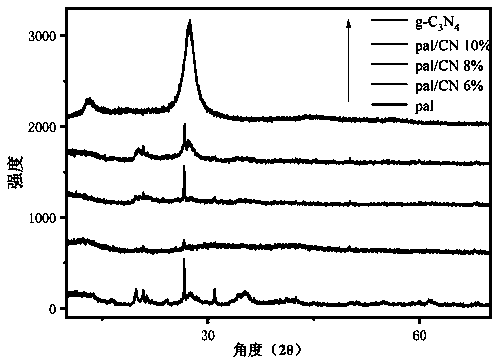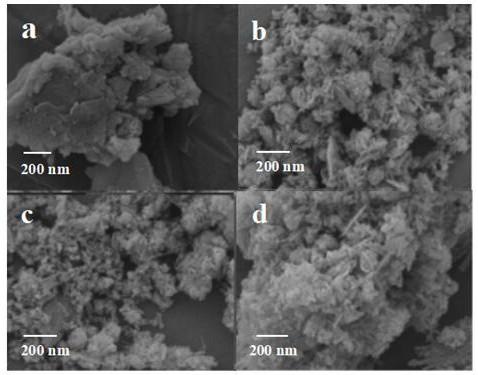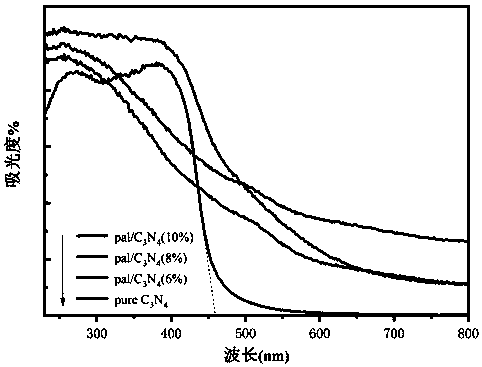Preparation and application of palygorskite/graphite phase carbon nitride compound composite material
A composite material, palygorskite technology, applied in the direction of silicon compound, special compound water treatment, chemical/physical process, etc., can solve the problem that the degradation performance of organic pollutants is not ideal, cannot provide reactive sites, and is difficult to uniformly Covering and other issues
- Summary
- Abstract
- Description
- Claims
- Application Information
AI Technical Summary
Problems solved by technology
Method used
Image
Examples
Embodiment 1
[0037] (1) Preparation of exfoliated palygorskite: Grind 10 g of raw ore palygorskite into powder, add 1 L of deionized aqueous solution to a large beaker and mechanically stir for 1 hour, stop stirring, let stand for 24 hours, remove the supernatant liquid, and extract The upper layer was precipitated, dried overnight at 100°C, added to 4 mol / L hydrochloric acid and stirred for 24 hours, washed five times with water, dried and ground for later use;
[0038] (2) pal / g-C 3 N 4 Preparation of (6%): Take 0.12 g of palygorskite prepared in step (1), add it to 100 ml of distilled water, ultrasonicate for 01 hour, then add 4 g of dicyandiamide, stir evenly, ultrasonicate for 1 hour, heat to 50°C and continue stirring Evaporate completely to dryness, grind into powder, calcined at 550°C for 4 hours, and grind into powder after cooling down to room temperature, which is pal / g-C 3 N 4 (6%) samples;
[0039] (3) Degradation performance of tetracycline hydrochloride: Degradation expe...
Embodiment 2
[0041] (1) Preparation of exfoliated palygorskite: same as in Example 1;
[0042] (2) pal / g-C 3 N 4 (8%) preparation: Take 0.16 g of palygorskite prepared in step (1) and add it to 100 ml of distilled water, ultrasonic for 1 hour, then add 4 g of dicyandiamide and stir evenly, then ultrasonic for 1 hour, heat to 50°C and continue stirring until Completely evaporated to dryness, ground into powder, calcined at 550°C for 4 hours, and ground into powder after cooling down to room temperature, which is the pal / g-C3N4 (8%) sample;
[0043] (3) Degradation performance of tetracycline hydrochloride: Degradation experiment was done under 800 watt xenon lamp, pal / g-C 3 N 4 (8%) The total removal rate of tetracycline hydrochloride reached 78%.
Embodiment 3
[0045] (1) Preparation of exfoliated palygorskite: same as in Example 1;
[0046] (2) pal / g-C 3 N 4 Preparation of (10%): Take 0.2 g of palygorskite prepared in step (1) and add it to 100 ml of distilled water, sonicate for 1 hour, then add 4 g of dicyandiamide, stir evenly, sonicate for 1 hour, heat to 45~50°C and continue Stir until completely evaporated to dryness, ground into powder, calcined at 550°C for 4 hours, and ground into powder after cooling down to room temperature, which is the pal / g-C3N4 (10%) sample;
[0047] (3) Degradation performance of tetracycline hydrochloride: Degradation experiment was done under 800 watt xenon lamp, pal / g-C 3 N 4 (10%) The total removal rate of tetracycline hydrochloride reached 57%.
PUM
 Login to View More
Login to View More Abstract
Description
Claims
Application Information
 Login to View More
Login to View More - R&D
- Intellectual Property
- Life Sciences
- Materials
- Tech Scout
- Unparalleled Data Quality
- Higher Quality Content
- 60% Fewer Hallucinations
Browse by: Latest US Patents, China's latest patents, Technical Efficacy Thesaurus, Application Domain, Technology Topic, Popular Technical Reports.
© 2025 PatSnap. All rights reserved.Legal|Privacy policy|Modern Slavery Act Transparency Statement|Sitemap|About US| Contact US: help@patsnap.com



